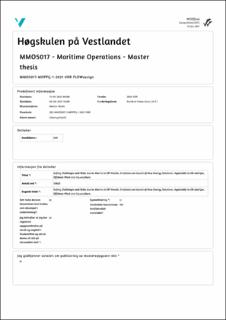| dc.description.abstract | Compared to regular sea-going vessels, DP vessels operate in an area with a high risk of accidents. This research investigates some of the main risks and challenges of DP vessels. Thus, the purpose is to investigate the research question related to safety challenges due to alarms and risks caused by new energy solutions. Furthermore, the research addresses issues facing alarm systems installed in DP vessels, their current technical requirements, and risks of position loss, fire and explosion due to hybrid fuel technology (hydrogen and battery).
This research provides a scientific rationale to find suggestions for improvements in DP vessels by using HTO Analysis for safety challenges and issues regarding alarm system. Examples of three accidents from the past and requirements and guidelines from regulatory bodies are qualitatively studied for evaluation and comparison with a survey performed among forty-five DPO and DP instructors. Risk analysis is conducted using bow-tie method for loss of position/heading and alternative fuel source in DP vessels. Risk picture for safety hazards and their consequences are assessed using impact load and collision energy due to rising interest in oil and gas exploration in the Barents Sea, and for the future use of hybrid solutions.
The research in alarm systems showed that alarm fatigue is widespread and unnecessary distractions in the bridge during DP operation are prevalent. The most alarming factors are lack of proper training in alarm error codes and messages, the absence of flexibility in the alarm system's adjustment, and manufacturers lacking interest in feedback from the end-user. The risk of position loss has many challenges, including cyber security and fire and explosions due to alternative fuel sources, requirement of better technology in the difficult weather conditions and lack of proper infrastructure. Challenges for hydrogen and battery-based hybrid solutions have issues in production, transportation, and distribution. Battery technology is yet premature and has issues in cooling system, power storage, and uncontrollable fire and explosions.
From this research, it is apparent that there is a need for improvements in humans, technology, and organizations. Personnel should engage in reporting undesirable events while keeping up with checklists and procedures. Operators and shipping companies must improve working culture towards safety and have a resilience engineering perspective towards accidents and High-Reliability Organization. Manufacturers should come back to the end-user for feedback to improve the alarm system on DP vessels. Two papers are written during this master’s thesis preparation and are attached in Appendix G and Appendix H. The papers will be published in proceedings of Marstruct 2021 Conference, Trondheim, and TransNav Journal, respectively. | en_US |

